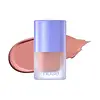What's inside
What's inside
 Key Ingredients
Key Ingredients

 Benefits
Benefits

No benefits
 Concerns
Concerns

 Ingredients Side-by-side
Ingredients Side-by-side

Phenyl Trimethicone
Skin ConditioningIsododecane
EmollientHydrogenated Polyisobutene
EmollientDiisostearyl Malate
EmollientPolyglyceryl-2 Triisostearate
EmulsifyingCyclopentasiloxane
EmollientSynthetic Wax
AbrasiveDimethicone/Vinyl Dimethicone Crosspolymer
Skin ConditioningDimethicone
EmollientDisteardimonium Hectorite
StabilisingSorbitan Sesquioleate
EmulsifyingTrimethylsiloxysilicate
EmollientC30-45 Alkyldimethylsilyl Polypropylsilsesquioxane
Dextrin Palmitate/Ethylhexanoate
EmulsifyingSilica Dimethyl Silylate
EmollientCI 77891
Cosmetic ColorantPropylene Carbonate
SolventChromium Hydroxide Green
Glyceryl Caprylate
EmollientCuprous Oxide
Skin ConditioningFerric Chloride
AstringentTriethoxycaprylylsilane
Aluminum Hydroxide
EmollientPhenyl Trimethicone, Isododecane, Hydrogenated Polyisobutene, Diisostearyl Malate, Polyglyceryl-2 Triisostearate, Cyclopentasiloxane, Synthetic Wax, Dimethicone/Vinyl Dimethicone Crosspolymer, Dimethicone, Disteardimonium Hectorite, Sorbitan Sesquioleate, Trimethylsiloxysilicate, C30-45 Alkyldimethylsilyl Polypropylsilsesquioxane, Dextrin Palmitate/Ethylhexanoate, Silica Dimethyl Silylate, CI 77891, Propylene Carbonate, Chromium Hydroxide Green, Glyceryl Caprylate, Cuprous Oxide, Ferric Chloride, Triethoxycaprylylsilane, Aluminum Hydroxide
Water
Skin ConditioningGlycerin
HumectantHydrogenated Polyisobutene
EmollientButylene Glycol
HumectantPropanediol
SolventPolyglyceryl-2 Triisostearate
EmulsifyingPolysorbate 80
Emulsifying1,2-Hexanediol
Skin ConditioningTitanium Dioxide
Cosmetic ColorantSodium Acrylate/Sodium Acryloyldimethyl Taurate Copolymer
Emulsion StabilisingIsohexadecane
EmollientBisabolol
MaskingCI 77491
Cosmetic ColorantCI 77499
Cosmetic ColorantPEG-10 Dimethicone
Skin ConditioningEthylhexylglycerin
Skin ConditioningParfum
MaskingRosa Damascena Flower Water
MaskingCI 77492
Cosmetic ColorantSorbitan Oleate
EmulsifyingPEG-240/Hdi Copolymer Bis-Decyltetradeceth-20 Ether
StabilisingTriethoxycaprylylsilane
Adenosine
Skin ConditioningAluminum Hydroxide
EmollientCI 15850
Cosmetic ColorantLinalool
PerfumingOpuntia Coccinellifera Fruit Extract
Skin ConditioningHydrolyzed Sodium Hyaluronate
Skin ConditioningSodium Hyaluronate
HumectantPotassium Laurate
EmulsifyingTocopherol
AntioxidantSodium Hyaluronate Crosspolymer
HumectantPotassium Hyaluronate
Skin ConditioningHydroxypropyltrimonium Hyaluronate
Hydrolyzed Hyaluronic Acid
HumectantHyaluronic Acid
HumectantSodium Acetylated Hyaluronate
HumectantWater, Glycerin, Hydrogenated Polyisobutene, Butylene Glycol, Propanediol, Polyglyceryl-2 Triisostearate, Polysorbate 80, 1,2-Hexanediol, Titanium Dioxide, Sodium Acrylate/Sodium Acryloyldimethyl Taurate Copolymer, Isohexadecane, Bisabolol, CI 77491, CI 77499, PEG-10 Dimethicone, Ethylhexylglycerin, Parfum, Rosa Damascena Flower Water, CI 77492, Sorbitan Oleate, PEG-240/Hdi Copolymer Bis-Decyltetradeceth-20 Ether, Triethoxycaprylylsilane, Adenosine, Aluminum Hydroxide, CI 15850, Linalool, Opuntia Coccinellifera Fruit Extract, Hydrolyzed Sodium Hyaluronate, Sodium Hyaluronate, Potassium Laurate, Tocopherol, Sodium Hyaluronate Crosspolymer, Potassium Hyaluronate, Hydroxypropyltrimonium Hyaluronate, Hydrolyzed Hyaluronic Acid, Hyaluronic Acid, Sodium Acetylated Hyaluronate
 Reviews
Reviews

Ingredients Explained
These ingredients are found in both products.
Ingredients higher up in an ingredient list are typically present in a larger amount.
Aluminum Hydroxide is a form of aluminum. It can be naturally found in nature as the mineral gibbsite. In cosmetics, Aluminum Hydroxide is used as a colorant, pH adjuster, and absorbent.
As a colorant, Aluminum Hydroxide may add opacity, or reduce the transparency. Aluminum hydroxide is contains both basic and acidic properties.
According to manufacturers, this ingredient is an emollient and humectant. This means it helps hydrate the skin.
In medicine, this ingredient is used to help relieve heartburn and help heal ulcers.
There is currently no credible scientific evidence linking aluminum hydroxide in cosmetics to increased cancer risk.
Major health organizations allow the use of aluminum hydroxide in personal care products and have not flagged it as a carcinogenic risk at typical usage levels.
Learn more about Aluminum HydroxideHydrogenated Polyisobutene is a synthetic polymer. Polymers are compounds with high molecular weight. Hydrogenated Polyisobutene is an emollient and texture enhancer.
In one study, Hydrogenated Polyisobutene showed better skin hydration levels than Caprylic/Capric Triglyceride. As an emollient, it helps keep your skin soft and hydrated by trapping moisture in.
Hydrogenated Polyisobutene is often used as a mineral oil replacement.
Learn more about Hydrogenated PolyisobuteneThis ingredient is a form of glycerin with emulsifying and emollient properties.
As an emulsifier, this ingredient helps keep products together while adding a thick texture. The manufacturer states this ingredient has emollient properties. Emollients help keep the skin hydrated by trapping moisture in.
Polyglyceryl-2 Triisostearate is created by reacting diglycerin and isostearic acid. Due to the isostearic acid base, it may not be safe for Malassezia or fungal acne.
Learn more about Polyglyceryl-2 TriisostearateTriethoxycaprylylsilane is a silicone used to bind and stabilize ingredients.
As an emulsifier, it helps prevent ingredients from separating. This can help elongate the shelf life of products.
Triethoxycaprylylsilane is often used to coat mineral sunscreens ingredients to help give a better feel. It also helps reduce oxidative stress in sunscreens.
Learn more about Triethoxycaprylylsilane